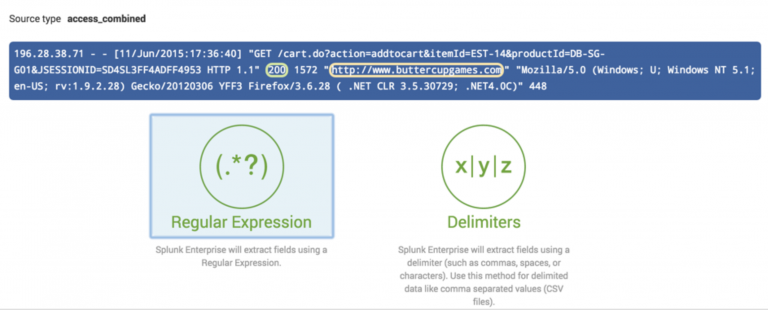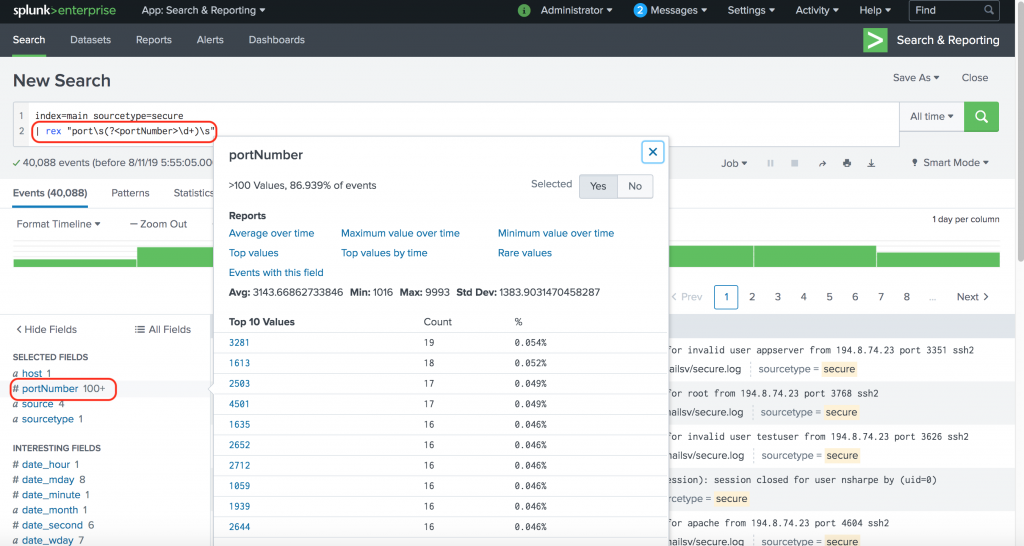
Splunk rex extract field manual#
About fields in the Knowledge Manager Manual.If entries in your tabular data do not contain a timestamp, the parser will not correctly detect which entry is the table header.įor more information, see the following Splunk Enterprise documentation: The parser assumes that all entries except the table header contain a timestamp. If your data contains more than 1000 events, the parser cannot automatically detect the field names. The Add-on Builder uses the first 1000 events for field extraction. Why are the field names not detected in my tabular data? Edit the sample data file by splitting the long lines to clean up the data.The sample data might contain an event that is too long: Because the Event Break option is applied when indexing the data, changing this value does not affect events that have already been indexed. Edit the source type and select a different option for Event Break.This error might indicate a problem with the Event Break setting for the source type: This error is displayed after attempting to parse a file, and the regular expression created by the Field Extractor contains more than 100 capture groups (fields). If you decide that you need to upload a different sample data file for a source type, for example you want to clean the data first, go to Manage source types, delete the sample data, then upload additional data files.Ī regular expression had too many capture groups, what do I do? Troubleshooting What if I need to upload different sample data? For Regex: select the regular expression to use, or create your own.Using the example key_a=value_a, key_b=value_b, the correct character is an equals sign. Specify the key-value delimiter character, which is used to separate keys and values.Using the example key_a=value_a, key_b=value_b, the correct character is a comma. Specify the pair delimiter character, which is used to separate key-value pairs.

For Delimiters, select the delimiters for the key-value pairs:.Auto to let the Add-on Builder parse data automatically.The Key Value format is used with data containing key-value pairs and lets you do the following: Note that each time you change delimiters, the number of columns might change and cause you to lose changes to field names. Change the field names after you have selected the correct delimiter.To specify a different character, click Other and enter the character. Change how data is parsed by selecting the delimiter character that is used to separate fields.The Table format is used with tabular data and lets you: Click the Trash icon next to a field name to remove its capture group from the regular expression.Click the Edit icon next to a field name to edit the field name.Click on individual field names to include or exclude the field for extraction.

Display the regular expression that the field extractor used, and modify it to improve the field extraction.Select one or more groups to represent the data.The Add-on Builder's field extractor displays a selection of events in groups, along with the extracted fields. To retrieve parsed field extractions, click Load Results for the source type.If you want to try parsing again using a different format, click Cancel to return to the previous page.Īfter data for a source type has been parsed, the source type is added to the table on the Extract Fields page.If you are satisfied with the results, click Save.If you aren't sure what format type you need and a format type has not been automatically selected, use "Unstructured Data" as the format type.Īfter parsing the data, the Add-on Builder displays the results on a summary page. Any detected format type is automatically selected and you can change the format type as needed. From Format, select the data format of the data.On the Extract Fields page, from Sourcetype, select a source type to parse.On your add-on homepage, click Extract Fields on the Add-on Builder navigation bar.To parse data for a source type and extract fields Data in the Extensible Markup Language (XML) format. Data in the JavaScript Object Notation (JSON) format. Data in tabular formats, such as comma-separated values (CSV) and tab-separated values (TSV). The Field Extractor supports parsing for the following data formats: To extract fields from your data, you must parse the data for each of the source types in your add-on.


Use Extract Fields functionality to parse the data in your source types and create field extractions.


 0 kommentar(er)
0 kommentar(er)
